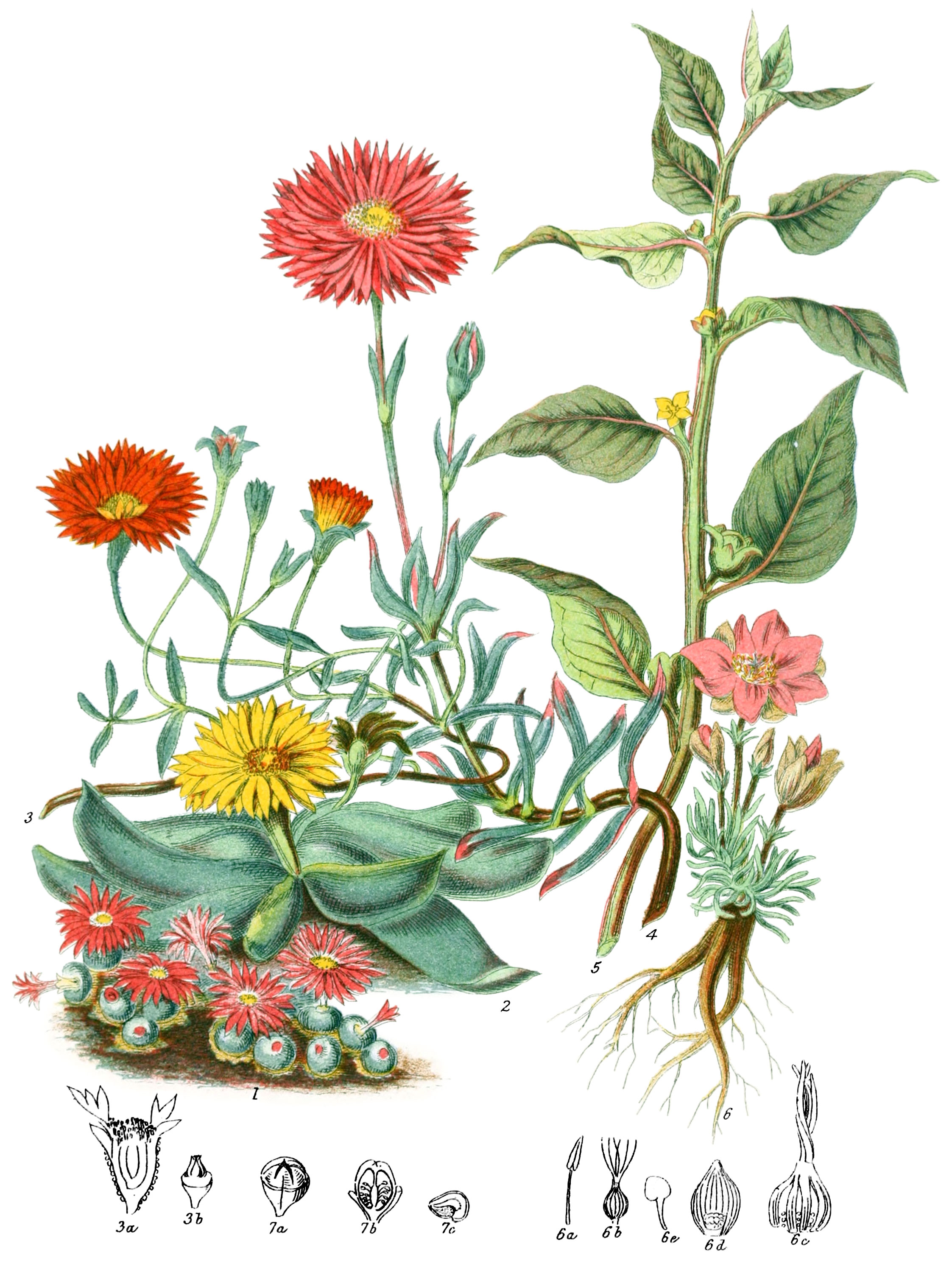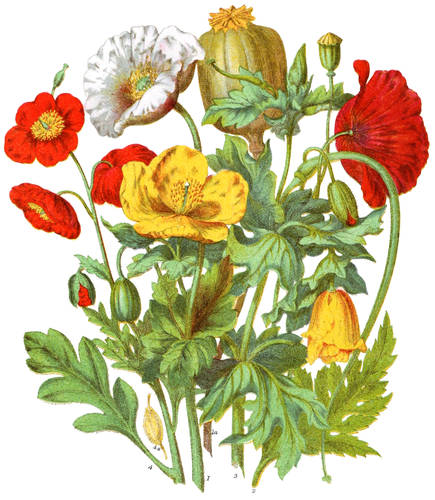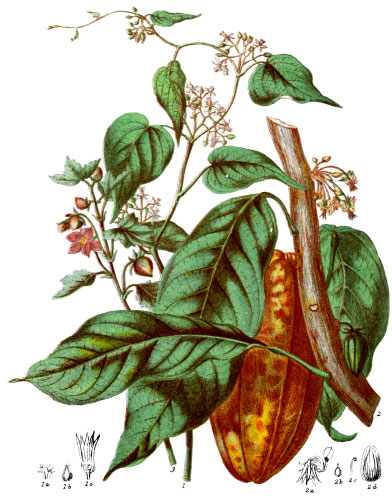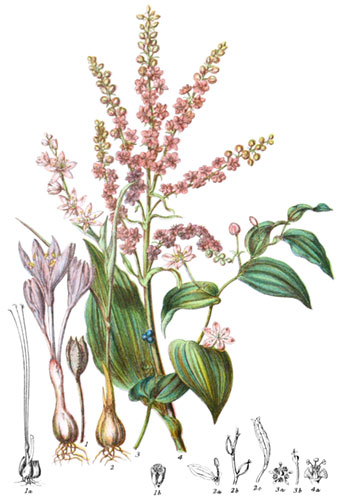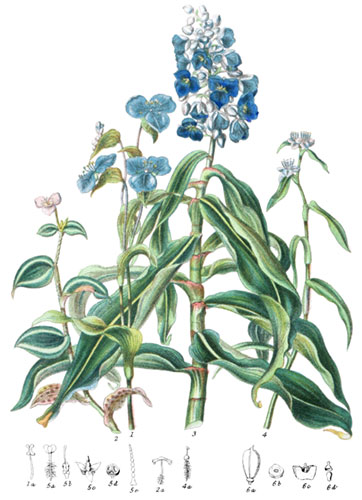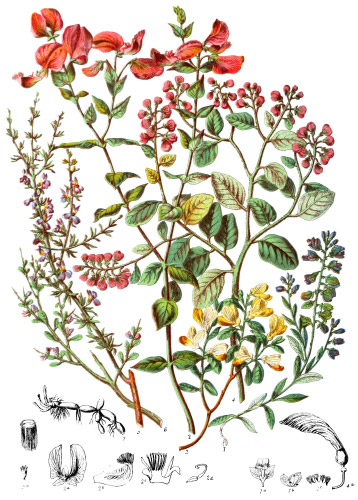Key characteristics
Shrubs and herbaceous succulent plants, with leaves opposite or alternate, simple, fleshy, often of grotesque forms, sometimes covered with watery protuberances, without stipules. The flowers are complete with stamens and pistil, almost always on terminal branches, sometimes from the base of the leaf-stalk; they are chiefly of brilliant color, generally opening only in sunshine, and closing in its absence. Tetragonia and a few other genera have small flowers, sometimes wanting in petals. The sepals of the calyx are usually five, more or less combined at the base, either cohering to the ovary or distinct from it, equal or unequal; the petals are slender, numerous, in many rows; the stamens arise from the calyx, and are of indefinite or definite number; the anthers are oblong. The ovary is partly below the calyx, one or many-celled; the styles are of the number of the cells, the stigmas numerous, distinct; the ovules are attached by cords to a central plate, which is either wholly free or united to the edges of the carpels, or spread over the cavity of each cell. The capsule is surrounded by the fleshy calyx, splitting at the base, or a tough-shelled nut not gaping when ripe. The seeds are attached to the inner angle of the cells, and contain merely albumen.
This order has affinity with Portulaceæ. Tetragonia connects it with Chenopodiaceæ.*
Slightly saline properties render these plants in some instances wholesome food; the ashes afford alkali.
Select plants in this order
Not all plants listed are illustrated and not all plants illustrated are listed.
- The species of Mesembryanthemum, or mid-day flowers, are of exceeding brightness and beauty; they continue to expand every morning for many weeks, and display their petals in the sunshine, of every tint of red, and yellow, and white. The succulent leaves assume a great variety of form; the fruit having sometimes the shape of a fig has given the name Fig-Marigold to the tribe.
- Mesembryanthemum edule affords food to the Hottentots in the fleshy fruit and leaves, whence it has been called Hottentot’s fig. These plants belong essentially to the Cape of Good Hope, a very few being scattered in Australia, New Zealand, and elsewhere.
- M. nodiflorum belongs to Egypt, where it is burnt for the sake of the excellent potash it produces.
- The best known of the species formerly, is M. crystallinum, the Ice-plant, introduced from Greece early in this century; the flowers are small and white, the leaves and stalks entirely covered with warts, containing a clear insipid liquid, having the appearance of bits of ice; in this country it is esteemed only as curious and ornamental; in Greece and in the Canaries it is eaten, and large quantities of the ashes are sent to Spain as Barilla.
- M. minutum (1) is remarkable for its singular globular leaves, resembling the form of some of the fungus tribe.
- M. depressum (2) and M. micans (3), besides several other species are generally cultivated in conservatories.
- M. spectabile (4) is one of the most showy, and is of extreme brilliancy in the sunshine.
- M. umbellatum is one of the largest species knwon, having a stout stem three feet high, bearing sweet-scented white flowers at the top.
- M. emarcidum, when bruised and fermented, acquires a narcotic property, and is used as tobacco by the Hottentots.
- M. æquilaterale affords an eatable fruit to the natives of Australia; it is above an inch in length; the pulp has a mixed flavour of sweet and saline.
- Tetragonia was named from the four-angled horny fruit; it partakes of the nature and habit of Chenopodiaceæ,* and like some of those plants, furnishes wholesome food.
- T. expansa (5) was found by Captain Cook in New Zealand, and used as an excellent vegetable. In Brazil it grows abundantly on the shores of the Rio Grande, and is very generally eaten by the Brazilians; on the continent of Europe it is now commonly preferred to any other kind of spinage, as it affords a constant supply of its succulent leaves throughout the summer.
- Lewisia (6), so called after Captain Lewis, who discovered it on the Rocky Mountains of North America, and introduced it to British gardens, where it is occasionally to be seen; the petals are sometimes very pale or white.
- Aizoon derives its name from Greek, always alive; the plants have a strong power of growth, and vegetate very readily.
- A. canariense and A. hispanicum, contain an abundant supply of soda.
- Sesuvium has no particular beauty; the species inhabit chiefly the West Indies and South America, and bear much resemblance to Purslane.
- S. portulacastrum is called in the East, Pepper Myrobalans, and is used as food either with milk, butter, or rice; it is also thought to have medicinal properties.
Locations
The principal portion of this Tribe inhabit the hot sandy plains of the Cape of Good Hope; a few species only exist in North Africa, in the countries of Europe bordering the Mediterranean, in China, in Chile,† Peru, and the South Sea Isles.
Legend
- Mesembryanthemum minutum, Tiny Fig-Marigold. Cape of Good Hope.
- Mesembryanthemum depressum, Depressed-leaved Fig-Marigold. Cape of Good Hope.
- Mesembryanthemum micans, Shining Fig-Marigold. Cape of Good Hope.
- Section of Flower.
- Pistils.
- Mesembryanthemum spectabile, Showy Fig-Marigold. Cape of Good Hope.
- Tetragonia expansa, New Zealand Spinage. New Zealand.
- Lewisia rediviva. North America.
- Stamen.
- Pistil.
- Capsule split.
- Section.
- Seed, magnified.
-
- Capsule of Mesembryanthemum.
- Section of Capsule.
- Section of Seed.
- *Chenopodiaceæ was spelled “Chenopodeaceæ” in the original description.
- †Chile was spelled “Chili” in the original description.
Explore more
Posters
Decorate your walls with colorful detailed posters based on Elizabeth Twining’s beautiful two-volume set from 1868.
Puzzles
Challenge yourself or someone else to assemble a puzzle of all 160 botanical illustrations.
